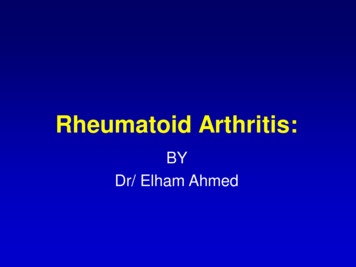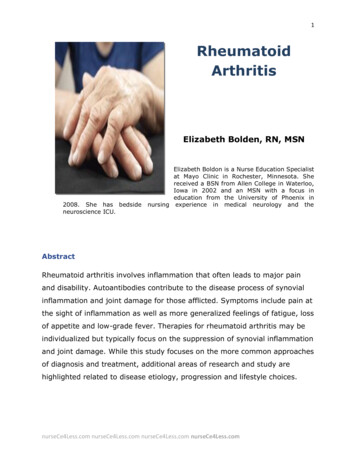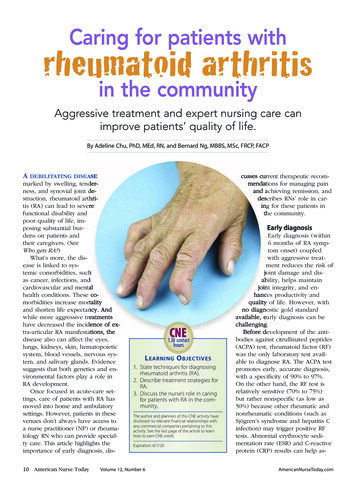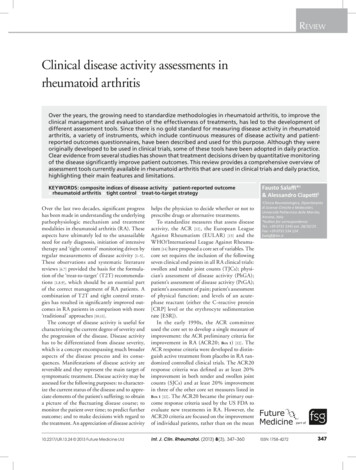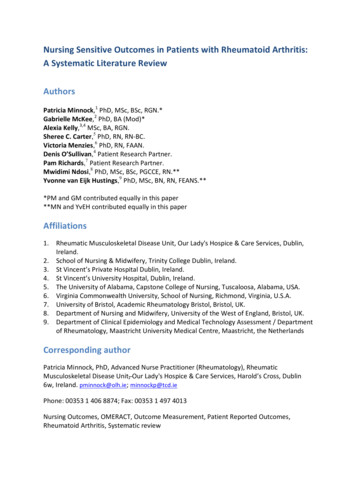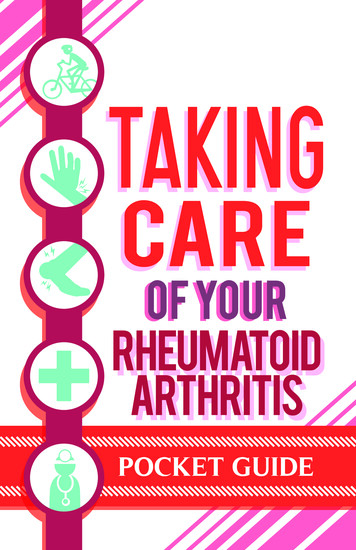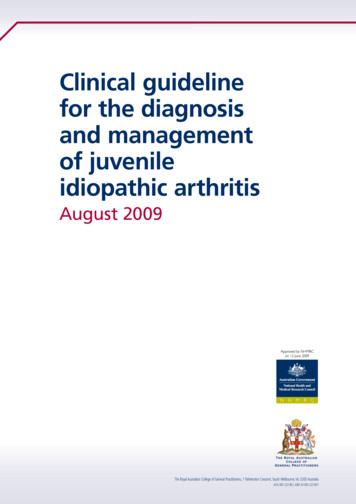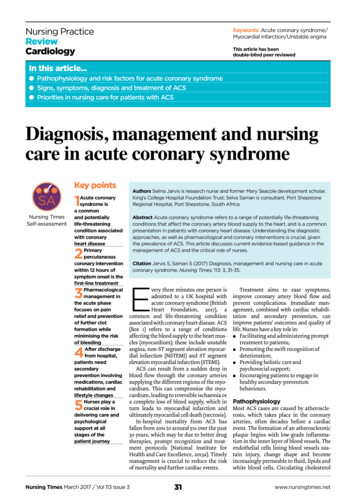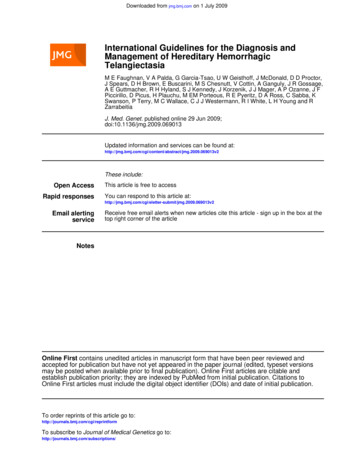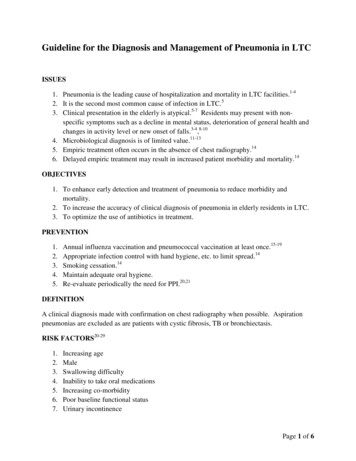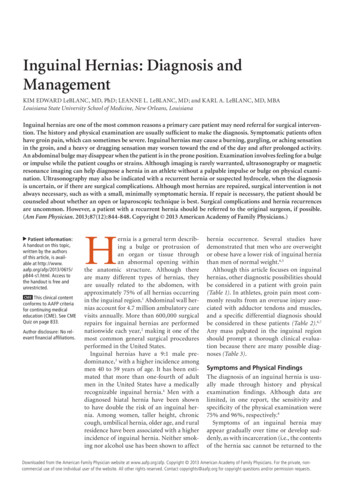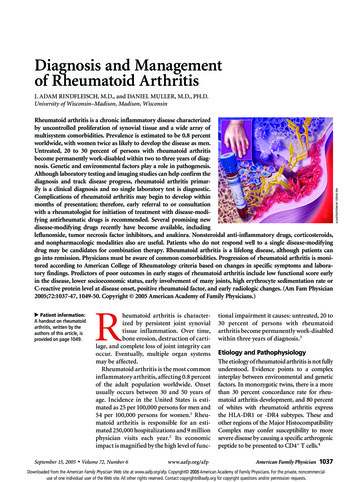
Transcription
Diagnosis and Managementof Rheumatoid ArthritisRheumatoid arthritis is a chronic inflammatory disease characterizedby uncontrolled proliferation of synovial tissue and a wide array ofmultisystem comorbidities. Prevalence is estimated to be 0.8 percentworldwide, with women twice as likely to develop the disease as men.Untreated, 20 to 30 percent of persons with rheumatoid arthritisbecome permanently work-disabled within two to three years of diagnosis. Genetic and environmental factors play a role in pathogenesis.Although laboratory testing and imaging studies can help confirm thediagnosis and track disease progress, rheumatoid arthritis primarily is a clinical diagnosis and no single laboratory test is diagnostic.Complications of rheumatoid arthritis may begin to develop withinmonths of presentation; therefore, early referral to or consultationwith a rheumatologist for initiation of treatment with disease-modifying antirheumatic drugs is recommended. Several promising newdisease-modifying drugs recently have become available, includingleflunomide, tumor necrosis factor inhibitors, and anakinra. Nonsteroidal anti-inflammatory drugs, corticosteroids,and nonpharmacologic modalities also are useful. Patients who do not respond well to a single disease-modifyingdrug may be candidates for combination therapy. Rheumatoid arthritis is a lifelong disease, although patients cango into remission. Physicians must be aware of common comorbidities. Progression of rheumatoid arthritis is monitored according to American College of Rheumatology criteria based on changes in specific symptoms and laboratory findings. Predictors of poor outcomes in early stages of rheumatoid arthritis include low functional score earlyin the disease, lower socioeconomic status, early involvement of many joints, high erythrocyte sedimentation rate orC-reactive protein level at disease onset, positive rheumatoid factor, and early radiologic changes. (Am Fam Physician2005;72:1037-47, 1049-50. Copyright 2005 American Academy of Family Physicians.) Patient information:A handout on rheumatoidarthritis, written by theauthors of this article, isprovided on page 1049.September 15, 2005 Rheumatoid arthritis is characterized by persistent joint synovialtissue inflammation. Over time,bone erosion, destruction of cartilage, and complete loss of joint integrity canoccur. Eventually, multiple organ systemsmay be affected.Rheumatoid arthritis is the most commoninflammatory arthritis, affecting 0.8 percentof the adult population worldwide. Onsetusually occurs between 30 and 50 years ofage. Incidence in the United States is estimated as 25 per 100,000 persons for men and54 per 100,000 persons for women.1 Rheumatoid arthritis is responsible for an estimated 250,000 hospitalizations and 9 millionphysician visits each year.2 Its economicimpact is magnified by the high level of func-tional impairment it causes: untreated, 20 to30 percent of persons with rheumatoidarthritis become permanently work-disabledwithin three years of diagnosis.3www.aafp.org/afp American Family Physician 1037Volume 72, Number 6Etiology and PathophysiologyThe etiology of rheumatoid arthritis is not fullyunderstood. Evidence points to a complexinterplay between environmental and geneticfactors. In monozygotic twins, there is a morethan 30 percent concordance rate for rheumatoid arthritis development, and 80 percentof whites with rheumatoid arthritis expressthe HLA-DR1 or -DR4 subtypes. These andother regions of the Major HistocompatibilityComplex may confer susceptibility to moresevere disease by causing a specific arthrogenicpeptide to be presented to CD4 T cells.4Downloaded from the American Family Physician Web site at www.aafp.org/afp. Copyright 2005 American Academy of Family Physicians. For the private, noncommercialuse of one individual user of the Web site. All other rights reserved. Contact copyrights@aafp.org for copyright questions and/or permission requests.ILLUSTRATION BY STEVE OHJ. ADAM RINDFLEISCH, M.D., and DANIEL MULLER, M.D., PH.D.University of Wisconsin–Madison, Madison, Wisconsin
SORT: Key Recommendations for PracticeClinical recommendationPatients with rheumatoid arthritis should be treated as early as possible with DMARDs to controlsymptoms and delay disease progression.Patients with persistent inflammatory joint disease (longer than six to eight weeks) already receivinganalgesics or NSAIDs should be considered for rheumatology referral, preferably within 12 weeks.Patient education, preferably one-to-one, should be provided when rheumatoid arthritis is diagnosed.NSAIDs should be prescribed in the lowest dose that provides symptom relief and should be cutback after a good response to DMARDs is achieved.Gastroprotection should be used if patients are older than 65 years or have a history of pepticulcer disease.Intra-articular corticosteroid injections can be helpful but should not be administered more thanthree times in one year.Low-dose oral corticosteroids are effective for symptom relief but have a high risk of toxicity;therefore, the lowest dosage possible should be used for the shortest period possible.Combination therapy may be more effective than treatment with one drug alone.Efficacy of treatment should be monitored; changes in hemoglobin, erythrocyte sedimentation rate,and C-reactive protein may indicate treatment response, and measurement instruments such as theEuropean League Against Rheumatism response criteria are useful for tracking disease progression.A multidisciplinary team approach is beneficial, at least in the short term; therefore, patients shouldhave access to a wide range of health care professionals, including their primary care physicians,rheumatologists, nursing specialists, physical therapists, occupational therapists, dietitians,podiatrists, pharmacists, and social workers.Exercise is beneficial for aerobic capacity and muscle strength with no detrimental effects on diseaseactivity or pain levels.EvidenceratingReferencesA2, 14, 15C13, 14CA2913B13C13A2AC2, 16-182, 35C30C28DMARD disease-modifying antirheumatic drug; NSAID nonsteroidal anti-inflammatory drug.A consistent, good-quality patient-oriented evidence; B inconsistent or limited-quality patient-oriented evidence; C consensus, diseaseoriented evidence, usual practice, expert opinion, or case series. For information about the SORT evidence rating system, see page 983 orhttp://www.aafp.org/afpsort.xml.Joint damage in rheumatoid arthritis begins with theproliferation of synovial macrophages and fibroblastsafter a triggering incident, possibly autoimmune orinfectious. Lymphocytes infiltrate perivascular regions,and endothelial cells proliferate. Neovascularizationthen occurs. Blood vessels in the affected joint becomeoccluded with small clots or inflammatory cells. Overtime, inflamed synovial tissue begins to grow irregularly,forming invasive pannus tissue. Pannus invades anddestroys cartilage and bone. Multiple cytokines, interleukins, proteinases, and growth factors are released,causing further joint destruction and the developmentof systemic complications.1,4risk factorsFemale sex, a positive family history, older age, silicateexposure, and smoking are associated with an increasedrisk for developing rheumatoid arthritis.1,5,6 Consumption of more than three cups of coffee daily—particularly decaffeinated coffee—also may contribute.7 Highvitamin D intake,8 tea consumption,7 and oral contraceptive use6 are associated with decreased risk. Threein four women with rheumatoid arthritis experiencesignificant improvement in symptoms when pregnant,1038 American Family Physicianusually with a recurrence after delivery.5 A systematicreview 9 of 24 studies did not support a link betweenbreast implants and connective tissue disorders.Diagnosistypical presentationRheumatoid arthritis primarily is a clinical diagnosis.Patients commonly present with pain and stiffness inmultiple joints, although one third of patients initiallyexperience symptoms at just one location or a few scattered sites. In most patients, symptoms emerge over weeksto months, starting with one joint and often accompanied by prodromal symptoms of anorexia, weakness, orfatigue. In approximately 15 percent of patients, onsetoccurs more rapidly over days to weeks. In 8 to 15 percentof patients, symptoms begin within a few days of a specific inciting event, such as an infectious illness.5Joints most commonly affected are those with thehighest ratio of synovium to articular cartilage. Thewrists are nearly always involved, as are the proximalinterphalangeal and metacarpophalangeal joints. Thedistal interphalangeal joints and sacroiliac joints tend notto be affected.5 Rheumatoid joints typically are boggy,tender to the touch, and warm, but they usually are notwww.aafp.org/afpVolume 72, Number 6 September 15, 2005
Rheumatoid Arthritistable 1Revised American Rheumatism Association Criteria for Classification of Rheumatoid ArthritisPercentage with rheumatoidarthritis if sign or symptom is*:Sign or symptomDefinitionMorning stiffnessStiffness in or around the affected joints for at leastone hour after initiating movementThree or more of the following joints noted to befluid-filled or have soft tissue swelling: wrist, PIP,MCP, elbow, knee, ankle, MTPWrist, MCP, or PIP joints among the symptomaticjoints observedRight and left joints involved for one or more offollowing: wrist, PIP, MCP, elbow, knee, ankle, MTP†Subcutaneous nodules in regions surrounding joints,extensor surfaces, or bony prominencesPositive result using any laboratory test that has apositive predictive value of 95 percent or more(i.e., is positive in no more than 5 percent ofpatients without rheumatoid arthritis)Hand and wrist films show typical changes of erosionsor loss of density adjacent to affected jointsArthritis of threeor more jointareasHand sSerum rheumatoidfactor positiveRadiographicchangesLR .629173.00.9850258.40.474130.8792111*—Assumes overall probability of rheumatoid arthritis of 30 percent.†—PIP, MCP, and MTP joints need not be absolutely symmetrical.LR positive likelihood ratio; LR negative likelihood ratio; PIP proximal interphalangeal; MCP metacarpophalangeal; MTP metatarsophalangeal.Information from references 11 and 12.erythematous. Some patients complain of “puffy” handssecondary to increased blood flow to inflamed areas.Prominent epitrochlear, axillary, and cervical lymphnodes may be noted. Muscles near inflamed joints oftenatrophy. Weakness is commonly out of proportionto pain on examination. Morning stiffness lasting atleast 45 minutes after initiating movement is common.Patients often hold joints in flexion to minimize painfuldistension of joint capsules. Low-grade fever, fatigue,malaise, and other systemic complaints may arise, especially in an acute presentation.5,10diagnostic criteriaIn clinical trials, rheumatoid arthritis is diagnosed formally using seven American Rheumatism Association(ARA) criteria (Table 1).11,12 In typical outpatient practice, a definitive diagnosis using these criteria may bedifficult to obtain early in the disease process. Duringthe initial visit, patients should be asked about degreeof pain, duration of stiffness and fatigue, and functionallimitations. A careful joint examination looking for thecharacteristics described above is vital.differential diagnosisRheumatoid arthritis must be differentiated from anumber of other disorders. Infection-related reactiveSeptember 15, 2005 Volume 72, Number 6arthropathies, seronegative spondyloarthropathies, andother connective tissue diseases such as systemic lupuserythematosus may have symptoms in common withrheumatoid arthritis, as may an array of endocrine andother disorders (Table 2).5,10 Gout rarely coexists withrheumatoid arthritis, and a joint aspiration should beconsidered if gout is suspected.diagnostic testsNo single diagnostic test definitively confirms the diagnosis of rheumatoid arthritis. However, several testscan provide objective data that increase diagnosticcertainty and allow disease progression to be followed.The American College of Rheumatology Subcommittee on Rheumatoid Arthritis (ACRSRA) recommendsthat baseline laboratory evaluations include a completeblood cell count with differential, rheumatoid factor,and erythrocyte sedimentation rate (ESR) or C-reactiveprotein (CRP). Baseline evaluation of renal and hepaticfunction also is recommended because these findingswill guide medication choices.2 Table 32,5,13 summarizesthe test findings associated with rheumatoid arthritis.TreatmentJoint destruction in rheumatoid arthritis begins withina few weeks of symptom onset; early treatment decreaseswww.aafp.org/afp American Family Physician 1039
table 2Differential Diagnosis of Rheumatoid ArthritisDiagnosisCommentsConnective tissue diseasesFibromyalgiaHemochromatosisInfectious endocarditisPolyarticular goutSuch as scleroderma and lupusEvaluate for trigger points.Iron studies and skin coloration changes may guide diagnosis.Rule out murmurs, high fever, and history of intravenous drug use.Joints often erythematous; podagra commonly found; gout and rheumatoid arthritis rarelycoexist, but calcium pyrophosphate deposition disease can accompany rheumatoid arthritis.Rheumatoid arthritis, unlike polymyalgia rheumatica, rarely presents with pain in the proximaljoints of the extremities only.Granulomas likely, as are hypercalcemia and chest film findings.Tend to be more asymmetric than rheumatoid arthritis. More commonly involve the joints ofthe spine. Evaluate for history of psoriasis, Reiter’s comorbidities, inflammatory bowel disease.Reactive arthritis can be postinfective, sexually acquired, or related to gastrointestinal disorders.Tends to present with fever, leukocytosis with left shift, sore throat, splenomegaly, liverdysfunction, and/or rash.Consider thyroid-stimulating hormone
15.09.2005 · Rheumatoid arthritis primarily is a clinical diagnosis. Patients commonly present with pain and stiffness in multiple joints, although one third of patients initially
